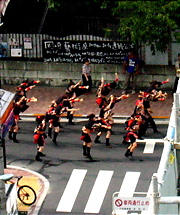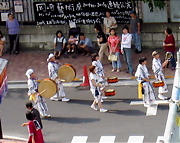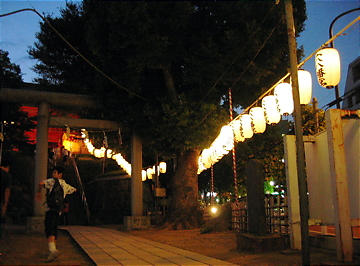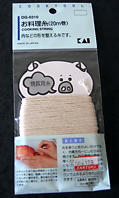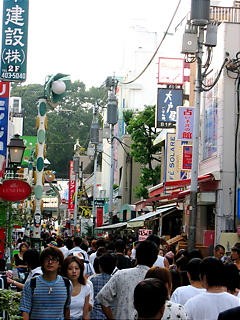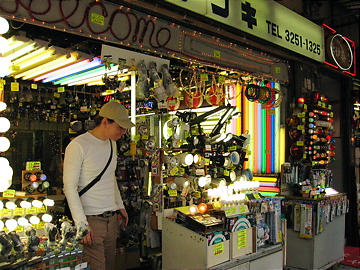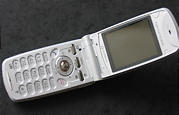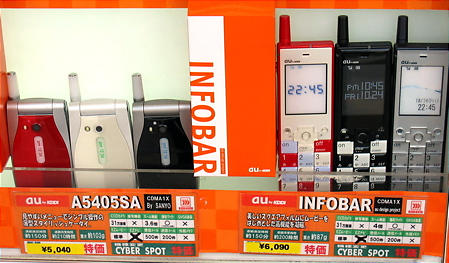« Shinjuku Sightseeing | Main | Iltak?velyll? Asakusassa »
September 23, 2004
Juhlia ja k?nnyk?it? / Festivities and Japanese Mobile Communication
T?lle viikolle on sattunut kaksi arkipyh??, ja molempina p?ivin? rauhallisen Wasedan alueeni on t?ytt?nyt rumpujen pauke. Maanantaina tutkija havahtui kammiossaan iloisiin sambarytmeihin! Ei ikin? uskoisi, miten iso ??ni niin pienest? b?ndist? ja kulkueesta l?htee. / This week there have been two public holidays and both times my quiet little Waseda neighbourhood has been filled with sounds from parades. You wouldn't believe how much noise a small group can make.
Jotkut paraatihahmoista olivat minulle oudompia. / Some of the parade characters were a bit more exotic.
Juhlap?ivin? my?s naapuruston shintolainen pyh?kk? oli juhlavalaistuksessa. / The festivities showed at the neighbouring shinto shrine as well.
V?lisoitto: Ruokakaupasta l?ysin t?m?n possun pulassa. (Paketissa on paistinarua.) / Interlude: Found this piggy in trouble at the supermarket.
Harajukussa on keskittym? kaikelle, mit? teini tai teinimielinen tarvitsee. Ja tungosta!
Siit? k?velymatkan p??ss? on paikallinen Esplanadi, Omotesando, jossa vierekk?in Armani, Dior, Anna Sui, Gap, jne., ymm?rr?tte, mit? tarkoitan. Hauskaa on se, ett? kadulla ja my?s kaupoissa kulkee kaikenn?k?ist? v?ke?, ei ainoastaan tyylitaitureita. My?s farkuissa voi menn? Diorin liikkeeseen, joka on kyll? ik??nkuin kadun presidentinlinna vartijoineen. Kallista on, ja kyll? on kaunistakin! Suomessa ei t?llaista designia juuri ole edes n?ht?vill?. Shibuyaan laskeutuessa tulee sitten vastaan kohtuuhintaisempia, hauskoja putiikkeja, jossa on kolmekymppisellekin sopivaa nuorisomuotia (odottakaa vaan miss? japaniar?yhel?iss? tulen t??lt?.)
Akihabaran kaupunginosassa taas on kaikki elektroniikka ja siihen liittyv? mit? ikin? tarvitset, tai haluat. (Tokiosta ylip??ns? saat halutessasi joka ikisen tavaran mit? maailmasta l?ytyy, pikkumutterista Armanin uniikkiasuun.) / In Akihabara, you have anything you need or want in electronics. (In Tokyo, in general, you can have any material thing you can possibly want in this world.)
Akihabarasta hankin k?nnykk?ni, tuhansien joukosta. Nolla jeni?, tv:ll?, kameralla ja radiolla varustettuna. / In Akihabara, I became a member of the ketai culture in Japan.
Ne englanninkielentaitoiset, joita asia kiinnostaa, voivat lukea lis?? k?nnyk?n hankkimisesta ao. linkist?. Kuvia voivat katsoa kaikki. Linkki alla "Continue reading...", ja sivua alas. / The process of getting a phone, subscribing to a service, and using the phone are quite different from what I am used to at home. In the link below, you find a memo on this basically for myself, but I'm publishing it here as it may be useful to others, too, who are interested in mobile communications in Japan or need to get a mobile phone in Japan. For others, it's boring. Just see the photos. Link: "Continue reading...", and scroll down.
Omahyv?inen esimerkki kuvasta, jollaisia k?nnyk?ll?ni saa. / A self-indulging example of the kind of photos you can take with my phone, by my colleague Legolas.
You can look and you can touch
The display and retail of the mobile phones in Japan is more relaxed than what we are used to at home. The phones are not sold only in shiny, air conditioned, operator-specific shops, but also in street corner kiosks that expand to the street. In these corner shops, a range of handset models and different operators are represented. In all shops, the models are free for the customer to play with at own will, not tucked away under a desk or held in a glass display and tried under the salesman's control. (For a photo, please see my entry from Sept 16th.)
Handset prices
Prices of the handsets vary from O ? to let's say 250 ?. In Japan, as in most countries, handsets are sold in connection to services from a certain operator. The operator buys phones from the manufacturer (Sanyo, Toshiba, Sharp, Panasonic, Mitsubishi, Nokia, Kyocera...) and subsidizes the price of the handset to the consumer when s/he subscribes to the operator's services. This way, the cheaper models can come free, whereas the newer models with more and fancier functions cost, but still much less than in Finland.
In Finland, selling a product in connection with another, so that the consumer cannot use one without the other ("kytkykauppa"), is illegal. However, right now, Fthe operator Elisa and manufacturer SonyEricsson are companies speaking for change and officials are considering it.
Service prices
The operator services in Japan, in turn, cost more than in Finland. Finnish consumer rights authorities would faint in front of all the possible, very oblique charge combinations.
The very basic framework is that you subscribe to a set monthly price plan, with my operator Vodafone varying from ca. 35 ? to 170 ? per month (there are eight options). This is what you pay whether you use the phone or not. A part of the monthly fee includes call and data services. Once you exceed that amount, you pay it on top of your monthly fee. For example, out of my 35? contract ca. 20? includes calls, e-mail, and other services. If I call and e-mail more than 20 ?, I pay extra. If don't use all of the 20 ?, it's my loss, I pay the 35? anyway.
The picture is blurred by a number of different bonuses, discounts, and additional charges for example when switching to another price plan, handset, or unsubscribing. (Just check out one of the operator's pages, operator names at the end.) You need to have a residence permit to Japan in order to open a subscription. Except a prepaid one, but they are expensive. (I got my subscription with the kind help of a colleague.)
Call costs vary, with my operator, from 10 to 60 yen per minute (ca. 8 cents to 45 cents) depending on the subscription type. The only cheap time of day is between 1am and 7pm, i.e. useless really. My cost, about 30 yen per minute, is a common price. Data services, on the other hand, are cheap: from 2yen to 8yen (1,5 to 6 cents) per message - the price of multimedia messages in Finland is five times as high, about 40 cents.
Services and functions
It is my understanding so far that in Japan, people do mostly use e-mail and other services rather than speak on the phone. Photos taken with the mobile phone camera are sent as attachments to e-mails, not as separate messages. Other services would mean games, tv, radio, video-conferencing, web content.
Tv and radio are free, as the handsets receive the broadcast directly. It is additional operator services (more data transfer, for example) and downloads that you need to pay extra or even subscribe separately for.
The functions on the phone are abundant. It serves, as is familiar from Finnish phones, as clock, alarm clock, calendar, calculator (in Japan, they have a special split costs among friends-setting for it but no currency settings as we do), memo book, but also as fortuneteller and animation composer. Also, you can set animation on your display and the characters will address you by name. In your reminders-list, you can stamp your reminders using 30 different options as the usual date, birthday, and dinner to "drive", "unlucky", "tv", "hospital visit", and reason for a reminder in Japan, "holiday".
Designs
There are only a few exceptions from the clamshell-type design available. One is Nokia 6650, and the only Japanese one I've seen, by Au (operator KDDI brand) and manufacturer Sanyo, at first looks a bit cheap. But after going through twenty clumsy, thick clamshells that all look more or less the same, this model becomes quite attractive. It's very thin but quite tall so it seems a bit impractical, but it is retro design here so that comes with the deal I suppose.
Some camera phones indeed look very much like cameras (in the middle row.)
Finnish teens refresh their phone designs with nail polish, but here, they have more advanced ways to do that. One is to buy the equivalent of keyrings to hang from your phone, varying from hello kitty toys to jewelry. Another is mobile phone tattoos, sold by a young Korean man in Akihabara. Both I'd like to see exported to Finland.
Usability and other problematics
As can be guessed from the variety of services and functions of these phones, usability is poor. After having my phone for less than a week, I have gone through sound settings so many times I cannot even remember to get them the way I want, and still I'm not sure whether that is the case. There are also functions I have no idea what they mean, like "close mode", or that are difficult to work out, like "manner mode" (this of course has to do with translation too.) There are many overlapping menus and also functions especially in sounds. After going through all the settings the first time to customise my phone and services, I felt I'd never be able to remember where to change a setting in case I would want to.
I was overjoyed with the e-mail service, as long as it turned out that after all, I cannot communicate to my Finnish e-mail friends with it. My photos get lost on the way and I can't see their e-mails at all. Oh well. Have to get a lot of Japanese friends to write to.
As pointed out by some of my colleagues, the input method by the user is inconvenient. I find Nokia SMS input irritating, but indeed writing with my Toshiba is even worse. My colleagues also criticize the tendency to push more and more operations and content to the mobile phone and consequently small screen. They also explanined that this tendency, and the popularity of the ketai is because of low pc use in Japan (compared to what we are used to.) For many young people thei mobile phone is the first and only computer they use.
I have a very boring, one of the most basic Nokia phones, but I'm already looking forward to going back to it. I will miss the little ku-man character on my display addressing me as Heli (although, with my Japanese, as far as I know she might be insulting me), listening to radio in the morning (well, at home I have a "real" one), and showing off the tv in my phone (I don't watch it myself here, but I might at home.) Perhaps I will after all become an enthousiastic 3G customer once I return to Finland - if it really finally works then.
All Japanese operators have English pages with good pictures of their models. The operators I am aware of are NTTDoCoMo, KDDI, and Vodafone.
Posted by hrantavu at September 23, 2004 09:09 AM

